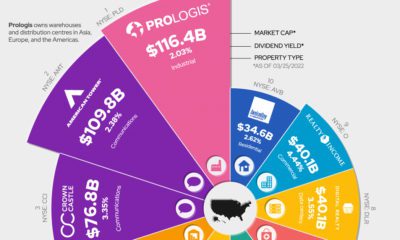Every generation thinks about investing a little differently. This is partially due to the fact that each cohort finds itself on a distinct leg of life’s journey. While boomers focus on retirement, Gen Zers are thinking about education and careers. As a result, it’s not surprising to find that investment objectives can differ by age group. However, there are other major reasons that contribute to each unique generational view. For example, what major world events shaped the mindset of each generation? Also, what role did culture play, and how do things like economic cycles factor in?
Finding Generational Discrepancies
Today’s infographic comes to us from Raconteur, and it showcases some of the most significant differences in how generations think about investing. Let’s dive into some of the most interesting data:
1. Investment Outlook
The majority of millennials (66%) are confident about investment opportunities in the next 12 months. This drops down to 49% when boomers are asked the same question.
2. Volatility
How did different generations of investors react to recent bouts of volatility in the market?
82% of millennials made changes to their portfolios 69% of Gen X made changes 47% of boomers made changes 32% of the Silent Generation made changes
3. Knowledge and Ability
In terms of investment knowledge, 42% of millennials considered themselves to be experts in the field. On the same question, only 23% of boomers could say the same.
4. Financial Goals
Back when they were 27 years old, 45% of Gen Xers said their primary goal was to buy a home. Compare this to just 23% of millennials that consider a home to be their primary investment objective today.
5. Managing Investments
The majority of millennials (66%) saw the ability to manage all aspects of personal finance, including investments, in the same app as being important. Only 35% of boomers agreed. Similarly, 67% of millennials saw recommendations made by artificial intelligence as being a basic part of any investment platform. Both Gen Xers and Baby Boomers were more hesitant, with 30% seeing computer-based recommendations as being integral.
6. Impact Investing
Millennials are twice as interested in ESG (environmental, social, and governance) investing, compared to their boomer counterparts. In fact, the majority of millennials (66%) choose funds according to ESG considerations.
Reasons for Not Investing
While generations may have varying investment philosophies, they seem a little more in sync when it comes to having reasons not to invest. There are some similarities in the data here – for example, non-investors of all generations seem to have an equally tough time learning about investing, and similar proportions do not believe they have the funds to start investing. On the flipside, it seems that millennials are more worried about their financial future, while simultaneously seeing a risk of “losing everything” stemming from investing. on Last year, stock and bond returns tumbled after the Federal Reserve hiked interest rates at the fastest speed in 40 years. It was the first time in decades that both asset classes posted negative annual investment returns in tandem. Over four decades, this has happened 2.4% of the time across any 12-month rolling period. To look at how various stock and bond asset allocations have performed over history—and their broader correlations—the above graphic charts their best, worst, and average returns, using data from Vanguard.
How Has Asset Allocation Impacted Returns?
Based on data between 1926 and 2019, the table below looks at the spectrum of market returns of different asset allocations:
We can see that a portfolio made entirely of stocks returned 10.3% on average, the highest across all asset allocations. Of course, this came with wider return variance, hitting an annual low of -43% and a high of 54%.
A traditional 60/40 portfolio—which has lost its luster in recent years as low interest rates have led to lower bond returns—saw an average historical return of 8.8%. As interest rates have climbed in recent years, this may widen its appeal once again as bond returns may rise.
Meanwhile, a 100% bond portfolio averaged 5.3% in annual returns over the period. Bonds typically serve as a hedge against portfolio losses thanks to their typically negative historical correlation to stocks.
A Closer Look at Historical Correlations
To understand how 2022 was an outlier in terms of asset correlations we can look at the graphic below:
The last time stocks and bonds moved together in a negative direction was in 1969. At the time, inflation was accelerating and the Fed was hiking interest rates to cool rising costs. In fact, historically, when inflation surges, stocks and bonds have often moved in similar directions. Underscoring this divergence is real interest rate volatility. When real interest rates are a driving force in the market, as we have seen in the last year, it hurts both stock and bond returns. This is because higher interest rates can reduce the future cash flows of these investments. Adding another layer is the level of risk appetite among investors. When the economic outlook is uncertain and interest rate volatility is high, investors are more likely to take risk off their portfolios and demand higher returns for taking on higher risk. This can push down equity and bond prices. On the other hand, if the economic outlook is positive, investors may be willing to take on more risk, in turn potentially boosting equity prices.
Current Investment Returns in Context
Today, financial markets are seeing sharp swings as the ripple effects of higher interest rates are sinking in. For investors, historical data provides insight on long-term asset allocation trends. Over the last century, cycles of high interest rates have come and gone. Both equity and bond investment returns have been resilient for investors who stay the course.













